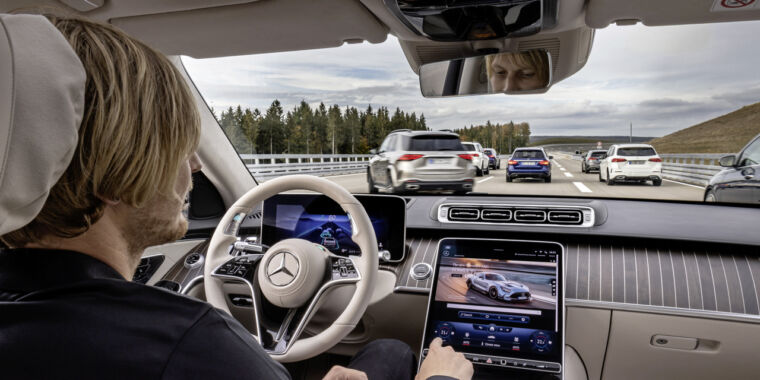
Mercedes-Benz
On Thursday, Mercedes-Benz became the world’s first automaker to gain regulatory approval for a so-called “level 3” self-driving system, perhaps better called a “conditionally automated driving system.” It’s called Drive Pilot, and it debuts next year in the new S-Class and EQS sedans, allowing the cars to drive themselves at up to 37 mph (60 km/h) in heavy traffic on geofenced stretches of highway.
Mercedes-Benz has offered various degrees of driver-assistance systems in the past, combining adaptive cruise control (which regulates the car’s speed) and lane-keeping assist (which tracks lane markers and uses the car’s steering to center it between them), but those were only “level 2” systems, as defined by SAE International. That means that although the car can accelerate, brake, and steer for itself, a human driver is still required to maintain situational awareness.
The new system is true automated driving as opposed to driver assistance. It uses a combination of radar, cameras, lidar, microphones (to detect emergency vehicles), and a moisture sensor, plus the car’s high-accuracy GNSS, which locates the car on an HD map.
When engaged, Drive Pilot takes over managing situational awareness. As a result, the system can handle unexpected traffic situations and can take evasive action if necessary. Drivers really can turn their minds—and their eyes—to something else, unlike with (the still-level 2) Super Cruise system from General Motors.
However, the operational design domain is even more tightly controlled than Super Cruise—like GM’s system, Drive Pilot will function only on premapped, geofenced, closed-access highways, and it will operate only at speeds of up to 37 mph.
Germany’s Federal Motor Transport Authority has been satisfied that the system is safe and has granted Mercedes-Benz approval to deploy Drive Pilot in the first half of 2022. Germany’s approval opens up a pathway for similar approval in the rest of the European Union, as well as Korea, Japan, Australia, and the UK.
